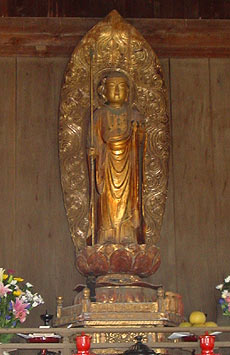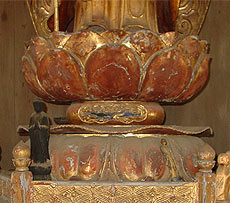|
||
 |
||
A lotus base that is a fully-opened flower is referred to as kaifu renge J~@Ψ (also read kaishiki renge). Mikaifu renge ’J~@Ψ is an unopened lotus, mibu renge ’~@Ψ is a lotus bud and shokatsu renge @Ψ is a slightly-opened lotus bud. These terms are more often applied to lotuses used as the hand-held attributes *jimotsu ¨ of bodhisattva images, especially *Kannon ΟΉ.
In its simplest form, the lotus base consists mainly of the *kaeribana ½Τ, which is a row of lotus petals turned downward. This was used for the 7c Kudara Kannonzou SΟΟΉ at Houryuuji @² in Nara . The so-called *daibutsuza ε§ΐ base supporting the Great Buddha *daibutsu ε§, is also in a simple form but has a kaeribana and a row of up-turned lotus petals called gyouren Β@. The simplified forms of the lotus base were often used in Asuka and Hakuhou periods sculptures. An unusual, early representation of a lotus-petal base is found in the 8c bronze Amida Sanzonzou ’νΙOΈ from the Tachibana miniature shrine, Tachibana fujin zushi kwl~q kept in the Houryuuji Treasure House. Each figure stands on a lotus with a twisting stem that rises out of a pond depicted in low relief.
A more complex, multi-level rengeza is believed to have been created by Jouchou θ© ( ?-1057; see *Jouchouyou θ©l) in the 11c. It consisted of the following sections with some variations: *renniku @χ (the lotus center); *renben @Ω (the lotus petals); a bulging sphere called uwa shikinasu γ~Φq; *keban ΨΥ (the flower platter); ukeza σΐ (a supporting pedestal that may be round, hexagonal or octogonal); another sphere refered to to as shita shikinasu Ί~Φq (lower shikinasu, see *shikinasu ~Φq); and two *kamachiza yΐ (platform frames). The Amida Nyoraizou ’νΙ@ at Byoudouin *Hououdou ½@P° (1053) is an example of an image with a complex lotus-pedestal but it only has one shikinasu. In very elaborate examples there may be additional components such as *kesoku Ψ«, decorative legs or supports that are positioned between the keban and the ukeza. The Senju Kannonzou ηθΟΉ (1154) at Bujouji τθ in Kyoto, has this type of base.
Another variation of the lotus pedestal is the fumiwari rengeza ₯@Ψΐ (also called fumiwake rengeza ₯ͺ@Ψΐ; lotus base with separate feet) in which there are separate lotus pedestals for each foot. Early examples include the celestial musicians depicted on the bronze octagonal lantern (8c) placed in front of the Daibutsuden ε§a at Toudaiji ε and the 9c *Godai Myouou άεΎ€ at Touji Koudou u°. This style of base was most popular in the Kamakura period, especially with Pure Land raigou imagery (see *raigou-zu }}), such as the Jizou Bosatsuzou n μF at Choumeiji ·½, Shiga prefecture, made by Eikai hυ in 1254. In many of the Kamakura period double-lotus format bases, the sides of the lotuses are joined together.
| @ | @ | @ |
 |
@ |  |
| Zizou Bosatsuzou n μFFShoufukuji Jizoudou ³n ° (Tokyo) | ||
| @ | ||
@
(C)2001 Japanese Architecture and Art Net Users System.@No reproduction or republication without written permission.
fΪΜeLXgEΚ^ECXgΘΗASΔΜRecΜ³f‘»E]ΪπΦΆά·B

